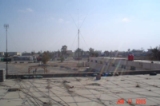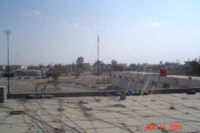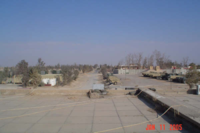
COB Speicher
Encyclopedia


2003 invasion of Iraq
The 2003 invasion of Iraq , was the start of the conflict known as the Iraq War, or Operation Iraqi Freedom, in which a combined force of troops from the United States, the United Kingdom, Australia and Poland invaded Iraq and toppled the regime of Saddam Hussein in 21 days of major combat operations...
. It was reassigned from a Forward Operating Base
Forward Operating Base
A forward operating base is any secured forward military position, commonly a military base, that is used to support tactical operations. A FOB may or may not contain an airfield, hospital, or other facilities. The base may be used for an extended period of time. FOBs are traditionally supported...
to a COB because of its large size. The Installation is located near Tikrit
Tikrit
Tikrit is a town in Iraq, located 140 km northwest of Baghdad on the Tigris river . The town, with an estimated population in 2002 of about 260,000 is the administrative center of the Salah ad Din Governorate.-Ancient times:...
in northern Iraq
Iraq
Iraq ; officially the Republic of Iraq is a country in Western Asia spanning most of the northwestern end of the Zagros mountain range, the eastern part of the Syrian Desert and the northern part of the Arabian Desert....
, approximately 170 kilometers north of Baghdad
Baghdad
Baghdad is the capital of Iraq, as well as the coterminous Baghdad Governorate. The population of Baghdad in 2011 is approximately 7,216,040...
and 11 kilometers west of the Tigris River. The airfield is served by two main runways measuring 10,000 and 9600 feet (2,926.1 m) long with a shorter runway measuring 7200 feet (2,194.6 m). It has been the location of the headquarters of the United States Forces-North (USF-N, formerly Multinational Division, North, (MND-N)) during the ongoing Iraq War. It is named after Scott Speicher
Scott Speicher
Michael Scott Speicher was a United States Navy pilot who was shot down over Iraq during the Gulf War. He was the first American combat casualty of the conflict. His remains were not recovered until Aug. 2, 2009...
, a U.S. Navy pilot who was Killed In Action
Killed in action
Killed in action is a casualty classification generally used by militaries to describe the deaths of their own forces at the hands of hostile forces. The United States Department of Defense, for example, says that those declared KIA need not have fired their weapons but have been killed due to...
in Iraq During the 1991 Gulf War when his F/A-18 Hornet was shot down by Captain Zuhair Dawood of the Iraqi air force.
Overview
American soldiers, civilians, and contractors have had access to a variety of amenities of the course of the United States' occupation of the base. A large, modern dining facility serves hot food every day. COB Speicher is home to an old soccer stadium where visiting bands perform today. There is a beauty salonBeauty salon
A beauty salon or beauty parlor is an establishment dealing with cosmetic treatments for men and women...
and spa
Spa
The term spa is associated with water treatment which is also known as balneotherapy. Spa towns or spa resorts typically offer various health treatments. The belief in the curative powers of mineral waters goes back to prehistoric times. Such practices have been popular worldwide, but are...
, a barber
Barber
A barber is someone whose occupation is to cut any type of hair, and to shave or trim the beards of men. The place of work of a barber is generally called a barbershop....
shop, cleaners
Dry cleaning
Dry cleaning is any cleaning process for clothing and textiles using a chemical solvent other than water. The solvent used is typically tetrachloroethylene , abbreviated "perc" in the industry and "dry-cleaning fluid" by the public...
/alterations, and a bazaar
Bazaar
A bazaar , Cypriot Greek: pantopoula) is a permanent merchandising area, marketplace, or street of shops where goods and services are exchanged or sold. The term is sometimes also used to refer to the "network of merchants, bankers and craftsmen" who work that area...
. Renovated Iraqi barracks, tents, and containerized housing unit
Containerized housing unit
Containerized Housing Unit, usually abbreviated as CHU is the name given to an ISO shipping container pre-fabricated into a living quarters...
s (CHUs) are used as housing for soldiers. CHUs are all wired for electricity and many have their own satellite television. The mail arrives daily at Speicher as opposed to only 2-3 times a week at outlying base camps. A large MWR (morale, welfare, recreation) facility contains Internet terminals, phones, big-screen TVs, PlayStations, pool tables, table tennis, libraries, and a lounge area. USO
United Service Organizations
The United Service Organizations Inc. is a private, nonprofit organization that provides morale and recreational services to members of the U.S. military, with programs in 160 centers worldwide. Since 1941, it has worked in partnership with the Department of Defense , and has provided support and...
tours occasionally come to COB Speicher.
Winter temperatures can drop to the upper 20s and low 30s. Units have heaters for their rooms to keep their quarters warm during these cold months. During the summer, temperatures can get up to around 130+ degrees. Most housing (whether a tent or containerized housing unit
Containerized housing unit
Containerized Housing Unit, usually abbreviated as CHU is the name given to an ISO shipping container pre-fabricated into a living quarters...
now have air conditioner/heater combinations. Satellite TV (Armed Forces Network and commercial) for sports and movies is available throughout the camp.
History
Prior to Operation Iraqi Freedom, Al-Sahra Air Base was the main base of the IrAF Air Academy. The base was one of several Iraqi Air Force airfields in the mid-1970s which were re-built under project "Super-Base" in response to the experiences from Arab-Israeli wars in 1967 and 1973.Originally, 13 airfields were re-built by British contractors, and on all of them also a number of hardened aircraft shelters was built. Subsequently companies from Yugoslavia - previously engaged in building bridges in Iraq - became involved. Due to their specific construction of these airfields - which included taxi-ways leading right out of Hardened Aircraft Shelters (HAS) and laid diagonally to the runways - they became known as "Trapezoids" or "Yugos".
The facilities were divided into two categories: "surface" and "underground". The "surface" facilities were actually the "softest", and included maintenance hangars of metal construction, and HAS of concrete construction. In total, the Yugoslavs have built no less but 200 HAS on different airfields in Iraq during the 1980s.
The protection of each HAS consisted of one meter thick concrete shells, reinforced by 30 cm thick steel plates. There was only one entrance and this was covered by sliding doors, made of 50 cm thick steel armoured plate and concrete. The HAS' were usually built in small groups - seldom more than five, with each group sharing the same water and power supply, besides having own backup gasoline-powered electrical generator, and each HAS being equipped with a semi-automatic aircraft-refuelling system.
In addition, underground facilities that could shelter between four and ten aircraft on average were constructed. In order to build these the Yugoslavs used equipment and construction techniques identical to that use in underground oil-storage depots, additionally conealing the extension and the true purpose of the whole project. The underground facilities were all hardened to withstand a direct hit by a tactical nuclear bomb, buried up to 50 meters bellow the ground and consisted of the main aircraft "hangar" (consisting of two floors in several cases, connected by 40ts hydraulic lifts), connected with operations, maintenance, and logistical facilities via a net of underground corridors.
Capture by United States forces
During OIF, only few of the runways and intersections were cut by hits, and many large hangar structures left intact, the Coalition planners leaving them purposefully intact. The Iraqis realized already before that it was futile to hide aircraft on them and thus resorted to dispersal, while the US officers wanted Al-Sahra to be captured intact so they could use it subsequently.The original unit to take control of the base was 1-10 Cavalry of the 4 Infantry Division and was handed over to 4th Aviation Brigade of the 4 Infantry Division in the 2nd week of the war. The US troops found 30 dispersed L-39 Aero Albatros, few MiG-15UTIs, more than 40 Zlins, and at least 50 other “light trainers.” A small number of Jet Provost airframes – used as ground instruction airframes – were also seen, but their condition not confirmed. In addition to these aircraft also five destroyed Su-20/-22s and two MiG-25s were found at the site.
COB Speicher had a large Post Exchange (PX), as well as several American fast food
Fast food
Fast food is the term given to food that can be prepared and served very quickly. While any meal with low preparation time can be considered to be fast food, typically the term refers to food sold in a restaurant or store with preheated or precooked ingredients, and served to the customer in a...
restaurants, including Subway
Subway (restaurant)
Subway is an American restaurant franchise that primarily sells submarine sandwiches and salads. It is owned and operated by Doctor's Associates, Inc. . Subway is one of the fastest growing franchises in the world with 35,519 restaurants in 98 countries and territories as of October 25th, 2011...
, Burger King
Burger King
Burger King, often abbreviated as BK, is a global chain of hamburger fast food restaurants headquartered in unincorporated Miami-Dade County, Florida, United States. The company began in 1953 as Insta-Burger King, a Jacksonville, Florida-based restaurant chain...
, and Pizza Hut
Pizza Hut
Pizza Hut is an American restaurant chain and international franchise that offers different styles of pizza along with side dishes including pasta, buffalo wings, breadsticks, and garlic bread....
.
Unit History
Units that have been based at COB Speicher include the (2003–2004) 4th Infantry Division 1-4 Aviation, 4th Infantry Division 2-4 Aviation, 42nd Infantry Division (Mechanized), 101st Airborne Division (Air Assault), elements of the 1st Infantry Division (Mechanized), 167th Corps Support Group,3rd Infantry Division (Mechanized), 4th Infantry Division (Mechanized), 25th Infantry Division (Light), 13th Corps Support Command, 287th Transportation Company (HET), 50th Main Support Battalion; Company B, 434th Main Support Battalion, 505th Parachute Infantry Regiment505th Parachute Infantry Regiment
The 505th Parachute Infantry Regiment is one of four infantry regiments of the 82nd Airborne Division of the United States Army.Activated in 1942, the regiment participated in the campaigns of Sicily, Salerno, Normandy, Holland and the Battle of the Bulge during World War II...
, HHC, Company B, Company D, 57th Signal Battalion, [141st Medical Company (GA)http://www.globalsecurity.org/military/agency/army/118med.htm Connecticut Army National Guard unit, Combat Aviation Brigade, 10th Mountain Division and others.
During 2004-2005 12th Chemical Company 701st MSB 1st Infantry Division supported transport and logistic units based at FOB Speicher supported US units in Kirkuk, Mosul and 5 subordinate bases. The 1404th Transportation Company (PLS) from the Arizona Army National Guard was stationed here in 2003 under the 4th Infantry Division. The 232nd Corps Support Battalion of the Illinois Army National Guard, 454th Transportation Company from the U.S. Army Reserves, and 88th RRC was stationed here from 2004 to 2005 under the 13th Corps Support Command/ 1st ID. Elements of the 3rd Squadron of the Tennessee National Guard's 278th Armored Cavalry Regiment were stationed at COB Speicher under the 13th Sustainment Command (Expeditionary) as convoy security units from February 2010 until July 2010. Elements of the Ohio National Guard's 16 Engineering Brigade
16th Engineer Brigade (United States)
The 16th Engineer Brigade is a combat engineer brigade of the United States Army National Guard of Ohio.The Brigade is responsible for a number of units throughout Ohio, most of which are also combat Engineer units.-History:...
were stationed here from 2003 through 2005 and helped bring the structures and roadways of the base to livable conditions.

